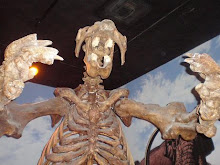The FGCU Marine Lab and Canoe Trip may have been the last field trip for University Colloquium, but it was by far the best. And could you guess why per chance that would be? Because my classmates and I were able to have first-hand contact with the outside environment. Being able to participate in such a fun past time as canoeing, while admiring the natural habitat of the Estero estuary was a great idea.
Certainly, much was learned about this estuary. The characteristics of mangroves was reinforced - they're chief benefit is to maintain the coastline, holding the ground in place. They also provide water filtration, especially the black mangrove. I was also pleased to learn that oysters were living in abundance there, but sadly I was not able to eat any, but still a fascinating fact. I had no idea they could live in such a place! The estuary was a network of canals that flow close to Estero Bay and the gulf. This was a particularly isolated and pristine place. Very beautiful.
I immensely enjoyed the canoeing. I would like to buy a kayak and do some rowing soon. This gave me a good idea of the type of exercise it is: very demanding, but it many ways relaxing. It's much like hiking a mountain, it will help me to take advantage of the peacefulness of nature.


These tubs (pictured above) were used to cultivate oysters. Where were the free samples?

At the left is a large network of mangrove roots. This demonstrates their land-holding ability and it makes sense that they can serve as water filters as well. These are in fact the red mangrove variety.

Featured at the right is a large specimen of a black mangrove. The leaves are white from the salt being absorbed through the roots. I have seen these and the red mangroves before, but it is obvious that they are essential to the ecosystem of Southwest Florida.
I managed to snap a shot of this spectacle while the canoe was in motion. Shown below is a flock of some native bird, probably a white ibis, but possibly a heron.


No comments:
Post a Comment